
Chapter 02 The Market System and the Circular Flow Answer Key
Multiple Choice Questions
1.
Which of the following is a distinguishing feature of a command system?
AACSB: Analytic
Accessibility: Keyboard Navigation
Blooms: Remember
Difficulty: 1 Easy
Learning Objective: 02-01 Differentiate between laissez-faire capitalism; the command system; and the market system.
Topic: Economic systems
2.
Which of the following is a distinguishing feature of laissez-faire capitalism?
AACSB: Analytic
Accessibility: Keyboard Navigation
Blooms: Remember
Difficulty: 1 Easy
Learning Objective: 02-01 Differentiate between laissez-faire capitalism; the command system; and the market system.
Topic: Economic systems
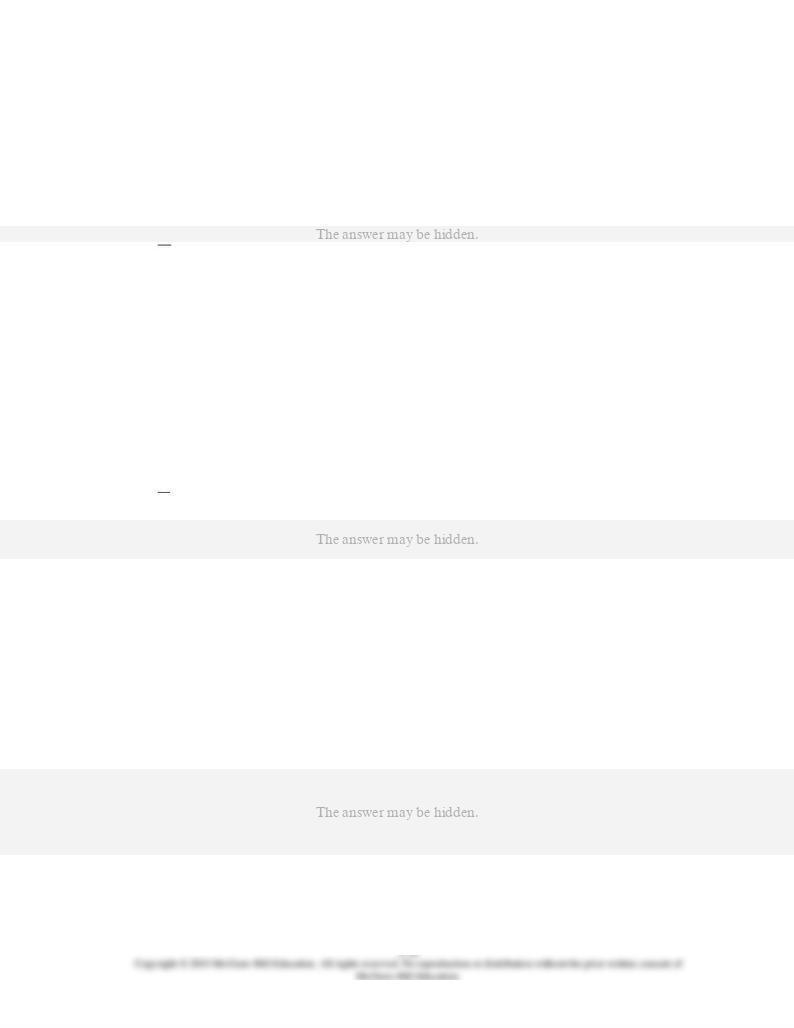
3.
Examples of command economies are:
A.
the United States and Japan.
B.
Sweden and Norway.
C.
Mexico and Brazil.
AACSB: Reflective Thinking
Accessibility: Keyboard Navigation
Blooms: Understand
Difficulty: 2 Medium
Learning Objective: 02-01 Differentiate between laissez-faire capitalism; the command system; and the market system.
Topic: Economic systems
4.
Of the following countries, which one best exhibits the characteristics of a market
economy?
A.
Canada.
B.
Cuba.
AACSB: Reflective Thinking
Accessibility: Keyboard Navigation
Blooms: Understand
Difficulty: 2 Medium
Learning Objective: 02-01 Differentiate between laissez-faire capitalism; the command system; and the market system.
Topic: Economic systems
5.
The French term "laissez-faire" means:
AACSB: Analytic
Accessibility: Keyboard Navigation
Blooms: Remember

Difficulty: 1 Easy
Learning Objective: 02-01 Differentiate between laissez-faire capitalism; the command system; and the market system.
Topic: Economic systems
6.
An economic system:
AACSB: Analytic
Accessibility: Keyboard Navigation
Blooms: Remember
Difficulty: 1 Easy
Learning Objective: 02-01 Differentiate between laissez-faire capitalism; the command system; and the market system.
Topic: Economic systems
7.
The term "laissez-faire" suggests that:
AACSB: Analytic
Accessibility: Keyboard Navigation
Blooms: Understand
Difficulty: 2 Medium
Learning Objective: 02-01 Differentiate between laissez-faire capitalism; the command system; and the market system.
Topic: Economic systems

8.
Economic systems differ according to which two main characteristics?
AACSB: Analytic
Accessibility: Keyboard Navigation
Blooms: Remember
Difficulty: 1 Easy
Learning Objective: 02-01 Differentiate between laissez-faire capitalism; the command system; and the market system.
Topic: Economic systems
9.
Command systems are also known as:
AACSB: Analytic
Accessibility: Keyboard Navigation
Blooms: Remember
Difficulty: 1 Easy
Learning Objective: 02-01 Differentiate between laissez-faire capitalism; the command system; and the market system.
Topic: Economic systems

10.
A fundamental difference between the command system and laissez-faire capitalism is
that, in command systems:
AACSB: Analytic
Accessibility: Keyboard Navigation
Blooms: Understand
Difficulty: 2 Medium
Learning Objective: 02-01 Differentiate between laissez-faire capitalism; the command system; and the market system.
Topic: Economic systems
11.
Which of the following is
not
a typical characteristic of a market system?
AACSB: Analytic
Accessibility: Keyboard Navigation
Blooms: Remember
Difficulty: 1 Easy
Learning Objective: 02-02 List the main characteristics of the market system.
Topic: Characteristics of the market system

12.
Which of the following is a fundamental characteristic of the market system?
AACSB: Analytic
Accessibility: Keyboard Navigation
Blooms: Remember
Difficulty: 1 Easy
Learning Objective: 02-02 List the main characteristics of the market system.
Topic: Characteristics of the market system
13.
Property rights are important because they:
AACSB: Analytic
Blooms: Understand
Difficulty: 2 Medium
Learning Objective: 02-02 List the main characteristics of the market system.
Topic: Characteristics of the market system
14.
Private property:
AACSB: Analytic
Accessibility: Keyboard Navigation
Blooms: Understand
Difficulty: 2 Medium

Learning Objective: 02-02 List the main characteristics of the market system.
Topic: Characteristics of the market system
15.
Copyrights and trademarks are examples of:
AACSB: Analytic
Accessibility: Keyboard Navigation
Blooms: Understand
Difficulty: 2 Medium
Learning Objective: 02-02 List the main characteristics of the market system.
Topic: Characteristics of the market system
16.
The regulatory mechanism of the market system is:
AACSB: Analytic
Accessibility: Keyboard Navigation
Blooms: Understand
Difficulty: 2 Medium
Learning Objective: 02-02 List the main characteristics of the market system.
Topic: Characteristics of the market system
17.
Broadly defined, competition involves:
AACSB: Analytic

Accessibility: Keyboard Navigation
Blooms: Remember
Difficulty: 1 Easy
Learning Objective: 02-02 List the main characteristics of the market system.
Topic: Characteristics of the market system
18.
Competition means that:
AACSB: Analytic
Accessibility: Keyboard Navigation
Blooms: Understand
Difficulty: 2 Medium
Learning Objective: 02-02 List the main characteristics of the market system.
Topic: Characteristics of the market system
19.
The division of labor means that:
AACSB: Analytic
Accessibility: Keyboard Navigation
Blooms: Remember
Difficulty: 1 Easy
Learning Objective: 02-02 List the main characteristics of the market system.
Topic: Characteristics of the market system

20.
Specialization in production is important primarily because it:
AACSB: Analytic
Accessibility: Keyboard Navigation
Blooms: Understand
Difficulty: 2 Medium
Learning Objective: 02-02 List the main characteristics of the market system.
Topic: Characteristics of the market system
21.
Specialization—the division of labor—enhances productivity and efficiency by:
AACSB: Analytic
Accessibility: Keyboard Navigation
Blooms: Understand
Difficulty: 2 Medium
Learning Objective: 02-02 List the main characteristics of the market system.
Topic: Characteristics of the market system
22.
Specialization in production is economically beneficial primarily because it:
AACSB: Analytic
Accessibility: Keyboard Navigation
Blooms: Understand
Difficulty: 2 Medium

Learning Objective: 02-02 List the main characteristics of the market system.
Topic: Characteristics of the market system
23.
On the basis of the information, it can be said that:
AACSB: Analytic
Blooms: Understand
Difficulty: 2 Medium
Learning Objective: 02-02 List the main characteristics of the market system.
Topic: Characteristics of the market system
Type: Figure
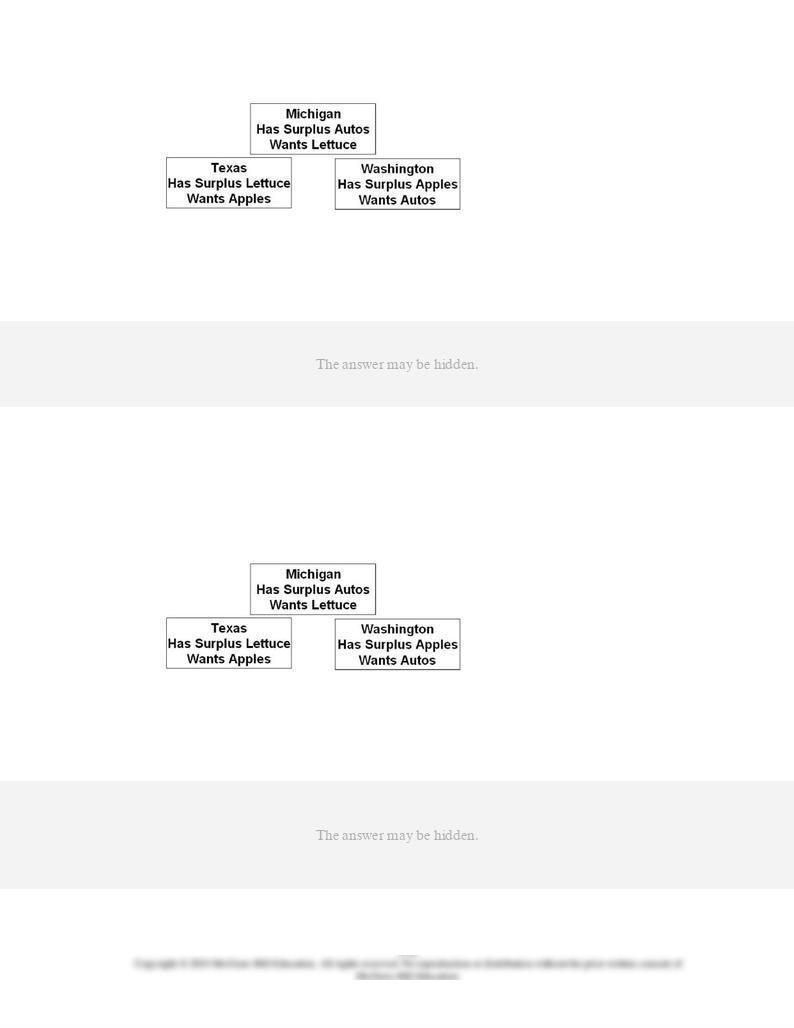
24.
On the basis of the information and assuming trade occurs between the three states, we
can expect:
AACSB: Reflective Thinking
Blooms: Apply
Difficulty: 2 Medium
Learning Objective: 02-02 List the main characteristics of the market system.
Topic: Characteristics of the market system
Type: Figure
25.
Given the information and assuming trade occurs between the three states, we can
expect:
AACSB: Reflective Thinking

Blooms: Apply
Difficulty: 2 Medium
Learning Objective: 02-02 List the main characteristics of the market system.
Topic: Characteristics of the market system
Type: Figure
26.
Barter:
AACSB: Analytic
Accessibility: Keyboard Navigation
Blooms: Remember
Difficulty: 1 Easy
Learning Objective: 02-02 List the main characteristics of the market system.
Topic: Characteristics of the market system
27.
The "coincidence of wants" problem associated with barter refers to the fact that:
AACSB: Analytic
Accessibility: Keyboard Navigation
Blooms: Understand
Difficulty: 2 Medium
Learning Objective: 02-02 List the main characteristics of the market system.
Topic: Characteristics of the market system

28.
The use of money contributes to economic efficiency because:
AACSB: Analytic
Accessibility: Keyboard Navigation
Blooms: Understand
Difficulty: 2 Medium
Learning Objective: 02-02 List the main characteristics of the market system.
Topic: Characteristics of the market system
29.
The presence of market failures implies that:
AACSB: Analytic
Accessibility: Keyboard Navigation
Blooms: Understand
Difficulty: 2 Medium
Learning Objective: 02-02 List the main characteristics of the market system.
Topic: Characteristics of the market system
30.
Which of the following characteristics is
least
unique to a market system?
AACSB: Analytic
Accessibility: Keyboard Navigation
Blooms: Understand

Difficulty: 2 Medium
Learning Objective: 02-02 List the main characteristics of the market system.
Topic: Characteristics of the market system
31.
Which of the following is one of the Five Fundamental Questions?
AACSB: Analytic
Accessibility: Keyboard Navigation
Blooms: Remember
Difficulty: 1 Easy
Learning Objective: 02-03 Explain how the market system answers the five fundamental questions of what to produce;
how to produce; who obtains the output; how to adjust to change; and how to promote progress.
Topic: Five fundamental questions
32.
If competitive industry Z is making substantial economic profit, output will:
AACSB: Reflective Thinking
Accessibility: Keyboard Navigation
Blooms: Apply
Difficulty: 2 Medium
Learning Objective: 02-03 Explain how the market system answers the five fundamental questions of what to produce;
how to produce; who obtains the output; how to adjust to change; and how to promote progress.
Learning Objective: 02-04 Explain the operation of the "invisible hand" and why market economies usually do a better job
than command economies at efficiently transforming economic resources into desirable output.
Topic: Five fundamental questions
Topic: Invisible hand

33.
From society's point of view, the economic function of profits and losses is to:
AACSB: Reflective Thinking
Accessibility: Keyboard Navigation
Blooms: Understand
Difficulty: 2 Medium
Learning Objective: 02-03 Explain how the market system answers the five fundamental questions of what to produce;
how to produce; who obtains the output; how to adjust to change; and how to promote progress.
Learning Objective: 02-04 Explain the operation of the "invisible hand" and why market economies usually do a better job
than command economies at efficiently transforming economic resources into desirable output.
Topic: Five fundamental questions
Topic: Invisible hand
34.
In a market economy a significant change in consumers' desire for product X will:
AACSB: Reflective Thinking
Accessibility: Keyboard Navigation
Blooms: Apply
Difficulty: 2 Medium
Learning Objective: 02-03 Explain how the market system answers the five fundamental questions of what to produce;
how to produce; who obtains the output; how to adjust to change; and how to promote progress.
Learning Objective: 02-04 Explain the operation of the "invisible hand" and why market economies usually do a better job
than command economies at efficiently transforming economic resources into desirable output.
Topic: Five fundamental questions
Topic: Invisible hand

35.
Economic profits in an industry suggest the industry:
AACSB: Reflective Thinking
Accessibility: Keyboard Navigation
Blooms: Analyze
Difficulty: 3 Hard
Learning Objective: 02-03 Explain how the market system answers the five fundamental questions of what to produce;
how to produce; who obtains the output; how to adjust to change; and how to promote progress.
Topic: Five fundamental questions
36.
Economic profits and losses:
AACSB: Analytic
Accessibility: Keyboard Navigation
Blooms: Understand
Difficulty: 2 Medium
Learning Objective: 02-03 Explain how the market system answers the five fundamental questions of what to produce;
how to produce; who obtains the output; how to adjust to change; and how to promote progress.
Learning Objective: 02-04 Explain the operation of the "invisible hand" and why market economies usually do a better job
than command economies at efficiently transforming economic resources into desirable output.
Topic: Five fundamental questions
Topic: Invisible hand

37.
If consumer desire for product X increases, all of the following will occur
except
:
AACSB: Reflective Thinking
Accessibility: Keyboard Navigation
Blooms: Apply
Difficulty: 2 Medium
Learning Objective: 02-03 Explain how the market system answers the five fundamental questions of what to produce;
how to produce; who obtains the output; how to adjust to change; and how to promote progress.
Learning Objective: 02-04 Explain the operation of the "invisible hand" and why market economies usually do a better job
than command economies at efficiently transforming economic resources into desirable output.
Topic: Five fundamental questions
Topic: Invisible hand
38.
An increase in consumer desire for strawberries is most likely to:
AACSB: Reflective Thinking
Accessibility: Keyboard Navigation
Blooms: Apply
Difficulty: 2 Medium
Learning Objective: 02-03 Explain how the market system answers the five fundamental questions of what to produce;
how to produce; who obtains the output; how to adjust to change; and how to promote progress.
Learning Objective: 02-04 Explain the operation of the "invisible hand" and why market economies usually do a better job
than command economies at efficiently transforming economic resources into desirable output.
Topic: Five fundamental questions
Topic: Invisible hand

39.
If competitive industry Y is incurring substantial losses, output will:
AACSB: Reflective Thinking
Accessibility: Keyboard Navigation
Blooms: Understand
Difficulty: 2 Medium
Learning Objective: 02-03 Explain how the market system answers the five fundamental questions of what to produce;
how to produce; who obtains the output; how to adjust to change; and how to promote progress.
Learning Objective: 02-04 Explain the operation of the "invisible hand" and why market economies usually do a better job
than command economies at efficiently transforming economic resources into desirable output.
Topic: Five fundamental questions
Topic: Invisible hand
40.
The economic function of profits and losses is to:
AACSB: Analytic
Accessibility: Keyboard Navigation
Blooms: Understand
Difficulty: 2 Medium
Learning Objective: 02-03 Explain how the market system answers the five fundamental questions of what to produce;
how to produce; who obtains the output; how to adjust to change; and how to promote progress.
Learning Objective: 02-04 Explain the operation of the "invisible hand" and why market economies usually do a better job
than command economies at efficiently transforming economic resources into desirable output.
Topic: Five fundamental questions
Topic: Invisible hand

41.
If a competitive industry is neither expanding nor contracting, we would expect:
AACSB: Reflective Thinking
Accessibility: Keyboard Navigation
Blooms: Understand
Difficulty: 2 Medium
Learning Objective: 02-03 Explain how the market system answers the five fundamental questions of what to produce;
how to produce; who obtains the output; how to adjust to change; and how to promote progress.
Topic: Five fundamental questions
42.
The competitive market system:
AACSB: Reflective Thinking
Accessibility: Keyboard Navigation
Blooms: Understand
Difficulty: 2 Medium
Learning Objective: 02-03 Explain how the market system answers the five fundamental questions of what to produce;
how to produce; who obtains the output; how to adjust to change; and how to promote progress.
Topic: Five fundamental questions

43.
In a market economy, the distribution of output will be determined primarily by:
AACSB: Analytic
Accessibility: Keyboard Navigation
Blooms: Understand
Difficulty: 2 Medium
Learning Objective: 02-03 Explain how the market system answers the five fundamental questions of what to produce;
how to produce; who obtains the output; how to adjust to change; and how to promote progress.
Topic: Five fundamental questions
44.
The most efficient combination of resources in producing a given output is the
combination that:
AACSB: Analytic
Accessibility: Keyboard Navigation
Blooms: Remember
Difficulty: 1 Easy
Learning Objective: 02-03 Explain how the market system answers the five fundamental questions of what to produce;
how to produce; who obtains the output; how to adjust to change; and how to promote progress.
Topic: Five fundamental questions

45.
Firms are motivated to minimize production costs because:
AACSB: Analytic
Accessibility: Keyboard Navigation
Blooms: Understand
Difficulty: 2 Medium
Learning Objective: 02-03 Explain how the market system answers the five fundamental questions of what to produce;
how to produce; who obtains the output; how to adjust to change; and how to promote progress.
Topic: Five fundamental questions
46.
Answer the question using the following data, which show all available techniques for
producing 20 units of a particular commodity:
Refer to the data. In view of the indicated resource prices, the economically most efficient
production technique(s) is (are) technique(s):
AACSB: Analytic
Blooms: Analyze
Difficulty: 3 Hard
Learning Objective: 02-03 Explain how the market system answers the five fundamental questions of what to produce;
how to produce; who obtains the output; how to adjust to change; and how to promote progress.
Topic: Five fundamental questions
Type: Table
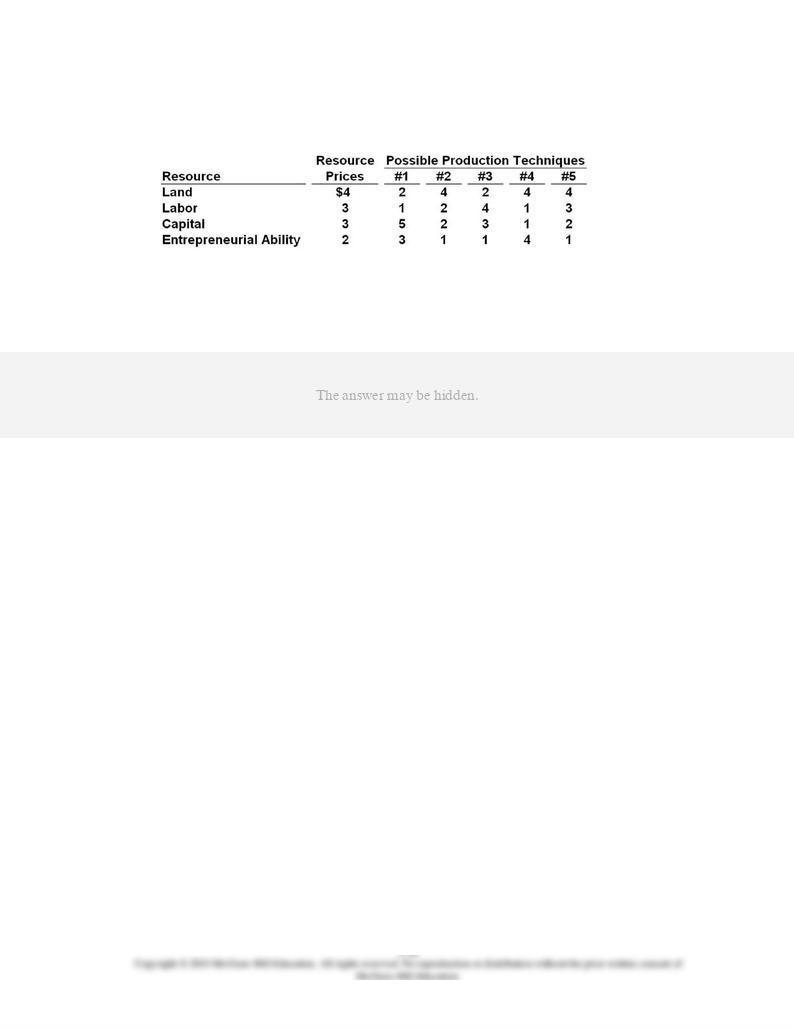
47.
Answer the question using the following data, which show all available techniques for
producing 20 units of a particular commodity:
Refer to the data. Assuming that the firm is motivated by self-interest and that the 20
units that can be produced with each technique can be sold for $2 per unit, the firm will:
AACSB: Analytic
Blooms: Apply
Difficulty: 2 Medium
Learning Objective: 02-03 Explain how the market system answers the five fundamental questions of what to produce;
how to produce; who obtains the output; how to adjust to change; and how to promote progress.
Topic: Five fundamental questions
Type: Table

48.
Answer the question using the following data, which show all available techniques for
producing 20 units of a particular commodity:
Refer to the data. If a new production technique is developed that enables a firm to
produce 20 units of output with 3 units of land, 3 of labor, 1 of capital, and 2 of
entrepreneurial ability, this technique would:
AACSB: Analytic
Blooms: Analyze
Difficulty: 3 Hard
Learning Objective: 02-03 Explain how the market system answers the five fundamental questions of what to produce;
how to produce; who obtains the output; how to adjust to change; and how to promote progress.
Topic: Five fundamental questions
Type: Table
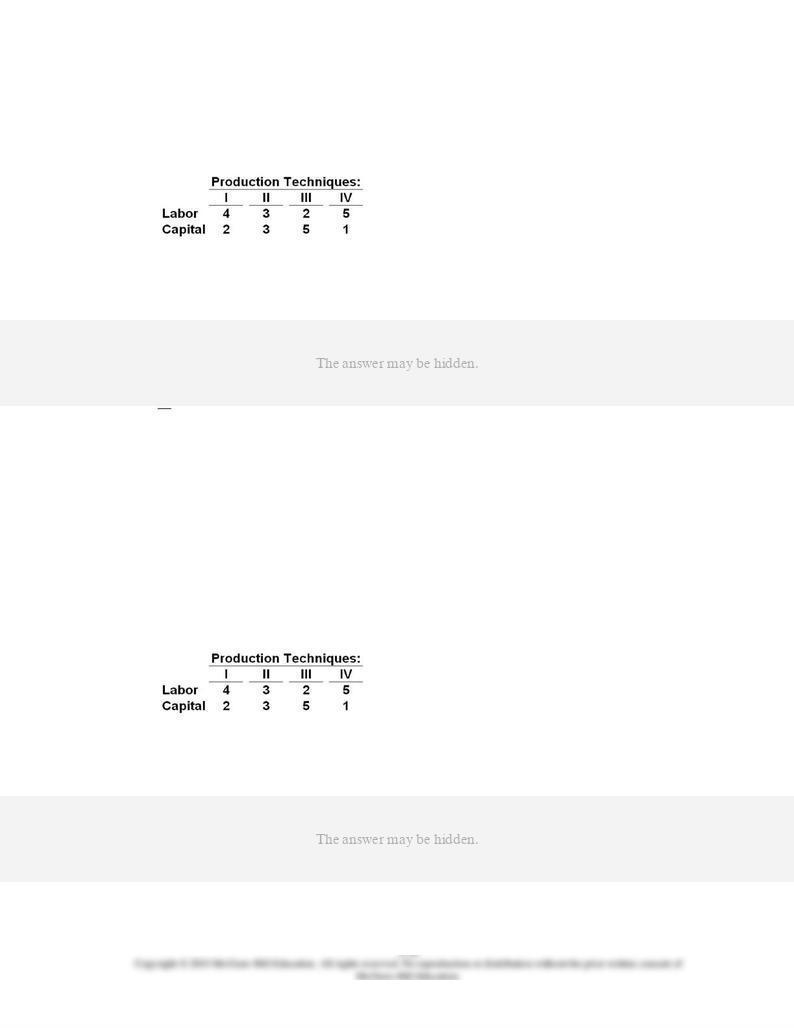
49.
Answer the question on the basis of the following information: Suppose 30 units of
product A can be produced by employing just labor and capital in the four ways shown
below. Assume the prices of labor and capital are $2 and $3 respectively.
Refer to the information. Which technique is economically most efficient in producing A?
AACSB: Analytic
Blooms: Analyze
Difficulty: 3 Hard
Learning Objective: 02-03 Explain how the market system answers the five fundamental questions of what to produce;
how to produce; who obtains the output; how to adjust to change; and how to promote progress.
Topic: Five fundamental questions
Type: Table
50.
Answer the question on the basis of the following information: Suppose 30 units of
product A can be produced by employing just labor and capital in the four ways shown
below. Assume the prices of labor and capital are $2 and $3 respectively.
Refer to the information. If the price of product A is $0.50, the firm will realize:
AACSB: Analytic
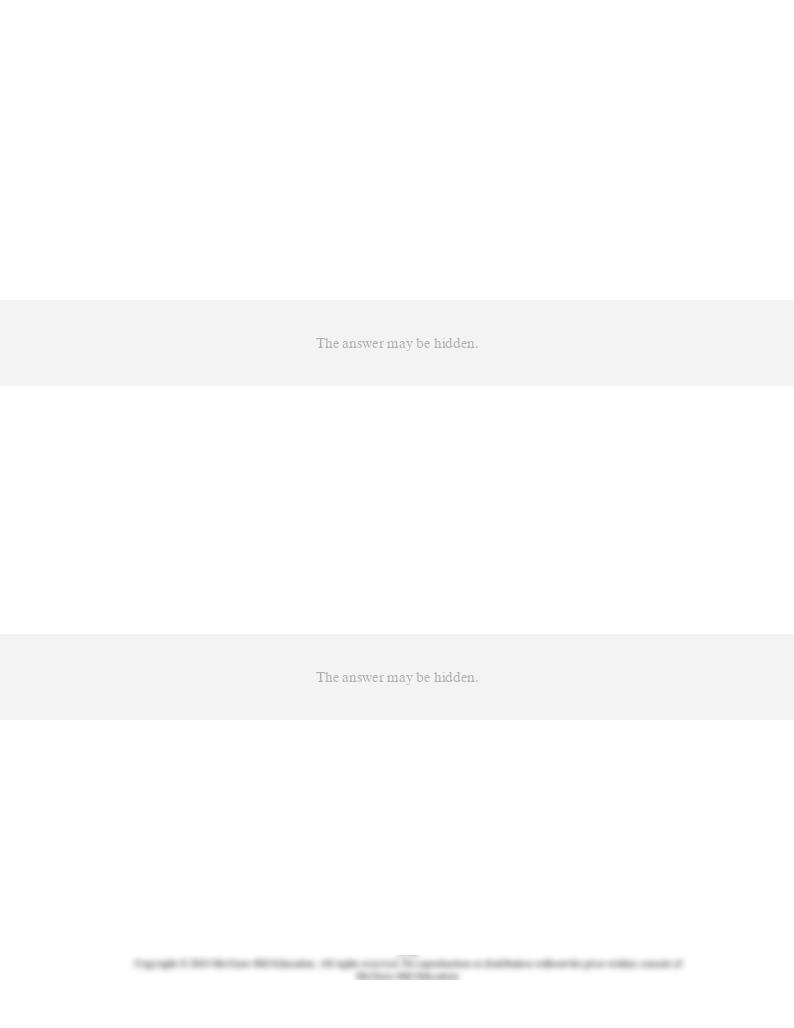
Blooms: Apply
Difficulty: 2 Medium
Learning Objective: 02-03 Explain how the market system answers the five fundamental questions of what to produce;
how to produce; who obtains the output; how to adjust to change; and how to promote progress.
Topic: Five fundamental questions
Type: Table
51.
In a competitive market economy, firms select the least-cost production technique
because:
AACSB: Reflective Thinking
Accessibility: Keyboard Navigation
Blooms: Understand
Difficulty: 2 Medium
Learning Objective: 02-03 Explain how the market system answers the five fundamental questions of what to produce;
how to produce; who obtains the output; how to adjust to change; and how to promote progress.
Topic: Five fundamental questions
52.
The market system's answer to the fundamental question "What will be produced?" is
essentially:
AACSB: Reflective Thinking
Accessibility: Keyboard Navigation
Blooms: Understand
Difficulty: 2 Medium
Learning Objective: 02-03 Explain how the market system answers the five fundamental questions of what to produce;
how to produce; who obtains the output; how to adjust to change; and how to promote progress.
Topic: Five fundamental questions

53.
The market system's answer to the fundamental question "How will the goods and
services be produced?" is essentially:
AACSB: Reflective Thinking
Accessibility: Keyboard Navigation
Blooms: Understand
Difficulty: 2 Medium
Learning Objective: 02-03 Explain how the market system answers the five fundamental questions of what to produce;
how to produce; who obtains the output; how to adjust to change; and how to promote progress.
Topic: Five fundamental questions
54.
The market system's answer to the fundamental question "Who will get the goods and
services?" is essentially:
AACSB: Reflective Thinking
Accessibility: Keyboard Navigation
Blooms: Understand
Difficulty: 2 Medium
Learning Objective: 02-03 Explain how the market system answers the five fundamental questions of what to produce;
how to produce; who obtains the output; how to adjust to change; and how to promote progress.
Topic: Five fundamental questions

55.
The market system's answer to the fundamental question "How will the system
accommodate change?" is essentially:
AACSB: Reflective Thinking
Accessibility: Keyboard Navigation
Blooms: Understand
Difficulty: 2 Medium
Learning Objective: 02-03 Explain how the market system answers the five fundamental questions of what to produce;
how to produce; who obtains the output; how to adjust to change; and how to promote progress.
Topic: Five fundamental questions
56.
The market system's answer to the fundamental question "How will the system promote
progress?" is essentially:
AACSB: Reflective Thinking
Accessibility: Keyboard Navigation
Blooms: Understand
Difficulty: 2 Medium
Learning Objective: 02-03 Explain how the market system answers the five fundamental questions of what to produce;
how to produce; who obtains the output; how to adjust to change; and how to promote progress.
Topic: Five fundamental questions

57.
The advent of DVDs has virtually demolished the market for videocassettes. This is an
example of:
AACSB: Reflective Thinking
Accessibility: Keyboard Navigation
Blooms: Apply
Difficulty: 2 Medium
Learning Objective: 02-03 Explain how the market system answers the five fundamental questions of what to produce;
how to produce; who obtains the output; how to adjust to change; and how to promote progress.
Topic: Five fundamental questions
58.
"Consumer sovereignty" refers to the:
AACSB: Analytic
Accessibility: Keyboard Navigation
Blooms: Understand
Difficulty: 2 Medium
Learning Objective: 02-03 Explain how the market system answers the five fundamental questions of what to produce;
how to produce; who obtains the output; how to adjust to change; and how to promote progress.
Topic: Five fundamental questions

59.
The dollar votes of consumers ultimately determine the composition of output and the
allocation of resources in a market economy. This statement best describes the concept
of:
AACSB: Analytic
Accessibility: Keyboard Navigation
Blooms: Remember
Difficulty: 1 Easy
Learning Objective: 02-03 Explain how the market system answers the five fundamental questions of what to produce;
how to produce; who obtains the output; how to adjust to change; and how to promote progress.
Topic: Five fundamental questions
60.
Which of the following is
not
one of the five fundamental questions?
AACSB: Analytic
Accessibility: Keyboard Navigation
Blooms: Remember
Difficulty: 1 Easy
Learning Objective: 02-03 Explain how the market system answers the five fundamental questions of what to produce;
how to produce; who obtains the output; how to adjust to change; and how to promote progress.
Topic: Five fundamental questions

61.
"Consumer sovereignty" means that:
AACSB: Analytic
Accessibility: Keyboard Navigation
Blooms: Understand
Difficulty: 2 Medium
Learning Objective: 02-03 Explain how the market system answers the five fundamental questions of what to produce;
how to produce; who obtains the output; how to adjust to change; and how to promote progress.
Topic: Five fundamental questions
62.
Which of the following best describes the invisible-hand concept?
AACSB: Analytic
Accessibility: Keyboard Navigation
Blooms: Remember
Difficulty: 1 Easy
Learning Objective: 02-04 Explain the operation of the "invisible hand" and why market economies usually do a better job
than command economies at efficiently transforming economic resources into desirable output.
Topic: Invisible hand

63.
The invisible hand refers to the:
AACSB: Analytic
Accessibility: Keyboard Navigation
Blooms: Understand
Difficulty: 2 Medium
Learning Objective: 02-04 Explain the operation of the "invisible hand" and why market economies usually do a better job
than command economies at efficiently transforming economic resources into desirable output.
Topic: Invisible hand
64.
The invisible hand concept suggests that:
AACSB: Reflective Thinking
Accessibility: Keyboard Navigation
Blooms: Understand
Difficulty: 2 Medium
Learning Objective: 02-04 Explain the operation of the "invisible hand" and why market economies usually do a better job
than command economies at efficiently transforming economic resources into desirable output.
Topic: Invisible hand

65.
Two major virtues of the market system are that it:
AACSB: Reflective Thinking
Accessibility: Keyboard Navigation
Blooms: Understand
Difficulty: 2 Medium
Learning Objective: 02-04 Explain the operation of the "invisible hand" and why market economies usually do a better job
than command economies at efficiently transforming economic resources into desirable output.
Topic: Invisible hand
66.
The market system:
AACSB: Reflective Thinking
Accessibility: Keyboard Navigation
Blooms: Understand
Difficulty: 2 Medium
Learning Objective: 02-04 Explain the operation of the "invisible hand" and why market economies usually do a better job
than command economies at efficiently transforming economic resources into desirable output.
Topic: Invisible hand

67.
According to the concept of the "invisible hand," if Susie opens and operates a profitable
childcare center, then:
AACSB: Reflective Thinking
Accessibility: Keyboard Navigation
Blooms: Apply
Difficulty: 2 Medium
Learning Objective: 02-04 Explain the operation of the "invisible hand" and why market economies usually do a better job
than command economies at efficiently transforming economic resources into desirable output.
Topic: Invisible hand
68.
The invisible hand promotes society's interests because:
AACSB: Reflective Thinking
Accessibility: Keyboard Navigation
Blooms: Understand
Difficulty: 2 Medium
Learning Objective: 02-04 Explain the operation of the "invisible hand" and why market economies usually do a better job
than command economies at efficiently transforming economic resources into desirable output.
Topic: Invisible hand

69.
The coordination problem in the centrally planned economies refers to the idea that:
AACSB: Analytic
Accessibility: Keyboard Navigation
Blooms: Understand
Difficulty: 2 Medium
Learning Objective: 02-01 Differentiate between laissez-faire capitalism; the command system; and the market system.
Learning Objective: 02-04 Explain the operation of the "invisible hand" and why market economies usually do a better job
than command economies at efficiently transforming economic resources into desirable output.
Topic: Demise of the command systems
70.
"Under central planning, some group has to decide how to get the necessary inputs
produced in the right amounts and delivered to the right places at the right time. This is a
nearly impossible task without markets and profits." This quotation best identifies the:
AACSB: Reflective Thinking
Accessibility: Keyboard Navigation
Blooms: Apply
Difficulty: 2 Medium
Learning Objective: 02-01 Differentiate between laissez-faire capitalism; the command system; and the market system.
Learning Objective: 02-04 Explain the operation of the "invisible hand" and why market economies usually do a better job
than command economies at efficiently transforming economic resources into desirable output.
Topic: Demise of the command systems

71.
"Because the outputs of many industries are the inputs to other industries, the failure of
any single industry to fulfill the output quantities specified in the central plan caused a
chain reaction of adverse repercussions on production." This quotation best identifies the:
AACSB: Reflective Thinking
Accessibility: Keyboard Navigation
Blooms: Apply
Difficulty: 2 Medium
Learning Objective: 02-01 Differentiate between laissez-faire capitalism; the command system; and the market system.
Learning Objective: 02-04 Explain the operation of the "invisible hand" and why market economies usually do a better job
than command economies at efficiently transforming economic resources into desirable output.
Topic: Demise of the command systems
72.
The incentive problem under communist central planning refers to the idea that:
AACSB: Reflective Thinking
Accessibility: Keyboard Navigation
Blooms: Understand
Difficulty: 2 Medium
Learning Objective: 02-01 Differentiate between laissez-faire capitalism; the command system; and the market system.
Learning Objective: 02-04 Explain the operation of the "invisible hand" and why market economies usually do a better job
than command economies at efficiently transforming economic resources into desirable output.
Topic: Demise of the command systems

73.
Suppose that an individual sees a tremendous opportunity to produce and sell a new
product but dismisses the idea because there is no way to exploit this opportunity for
personal gain. This situation best identifies the:
AACSB: Reflective Thinking
Accessibility: Keyboard Navigation
Blooms: Apply
Difficulty: 2 Medium
Learning Objective: 02-01 Differentiate between laissez-faire capitalism; the command system; and the market system.
Learning Objective: 02-04 Explain the operation of the "invisible hand" and why market economies usually do a better job
than command economies at efficiently transforming economic resources into desirable output.
Topic: Demise of the command systems
74.
Innovation lagged in the centrally planned economies because:
AACSB: Reflective Thinking
Accessibility: Keyboard Navigation
Blooms: Understand
Difficulty: 2 Medium
Learning Objective: 02-01 Differentiate between laissez-faire capitalism; the command system; and the market system.
Learning Objective: 02-04 Explain the operation of the "invisible hand" and why market economies usually do a better job
than command economies at efficiently transforming economic resources into desirable output.
Topic: Demise of the command systems

75.
The fact that the major indicator of enterprise success in the Soviet Union and pre-reform
China was the quantity of output implied that:
AACSB: Reflective Thinking
Accessibility: Keyboard Navigation
Blooms: Analyze
Difficulty: 3 Hard
Learning Objective: 02-01 Differentiate between laissez-faire capitalism; the command system; and the market system.
Learning Objective: 02-04 Explain the operation of the "invisible hand" and why market economies usually do a better job
than command economies at efficiently transforming economic resources into desirable output.
Topic: Demise of the command systems
76.
Enterprise managers and workers in the Soviet Union often resisted innovations in
production methods because:
AACSB: Reflective Thinking
Accessibility: Keyboard Navigation
Blooms: Remember
Difficulty: 1 Easy
Learning Objective: 02-01 Differentiate between laissez-faire capitalism; the command system; and the market system.
Learning Objective: 02-04 Explain the operation of the "invisible hand" and why market economies usually do a better job
than command economies at efficiently transforming economic resources into desirable output.
Topic: Demise of the command systems

77.
If products were in short or surplus supply in the Soviet Union:
AACSB: Reflective Thinking
Accessibility: Keyboard Navigation
Blooms: Remember
Difficulty: 1 Easy
Learning Objective: 02-01 Differentiate between laissez-faire capitalism; the command system; and the market system.
Learning Objective: 02-04 Explain the operation of the "invisible hand" and why market economies usually do a better job
than command economies at efficiently transforming economic resources into desirable output.
Topic: Demise of the command systems
78.
In what type of business do the owners bear no personal financial responsibility for the
company's debts and obligations?
AACSB: Analytic
Accessibility: Keyboard Navigation
Blooms: Remember
Difficulty: 1 Easy
Learning Objective: 02-05 Describe the mechanics of the circular flow model.
Topic: Circular flow model

79.
The simple circular flow model shows that:
AACSB: Analytic
Accessibility: Keyboard Navigation
Blooms: Remember
Difficulty: 1 Easy
Learning Objective: 02-05 Describe the mechanics of the circular flow model.
Topic: Circular flow model
80.
The two basic markets shown by the simple circular flow model are:
AACSB: Analytic
Accessibility: Keyboard Navigation
Blooms: Remember
Difficulty: 1 Easy
Learning Objective: 02-05 Describe the mechanics of the circular flow model.
Topic: Circular flow model
81.
In the resource market:
AACSB: Analytic
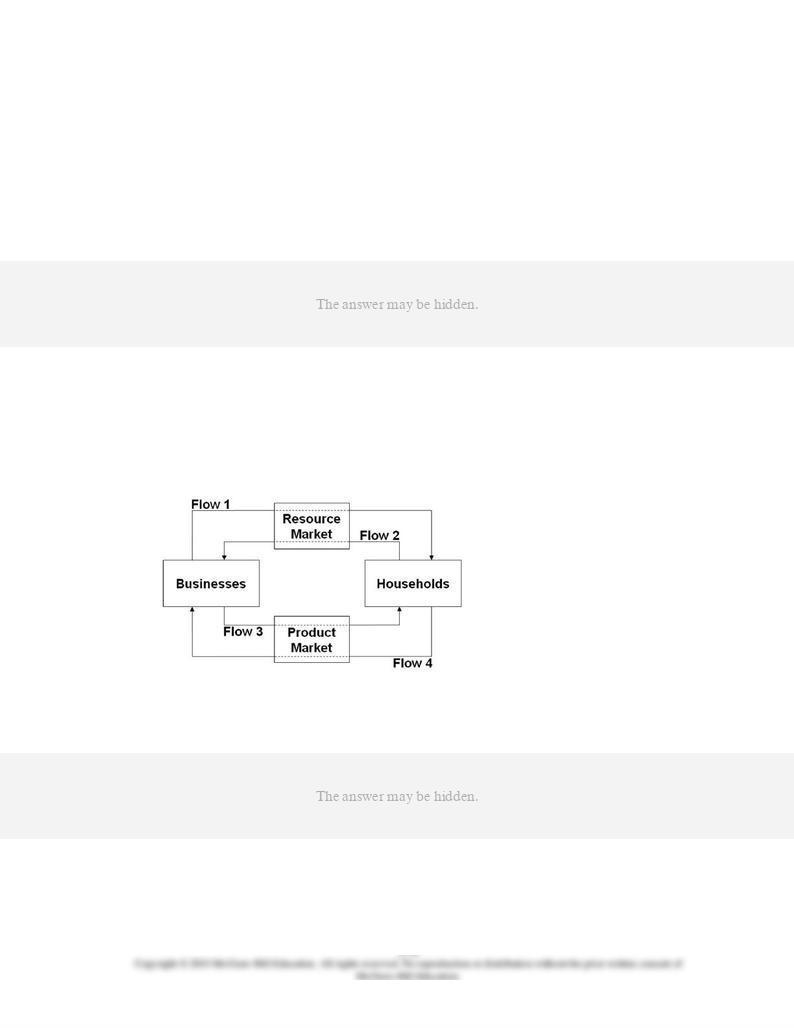
Accessibility: Keyboard Navigation
Blooms: Remember
Difficulty: 1 Easy
Learning Objective: 02-05 Describe the mechanics of the circular flow model.
Topic: Circular flow model
82.
In the simple circular flow model:
AACSB: Analytic
Accessibility: Keyboard Navigation
Blooms: Remember
Difficulty: 1 Easy
Learning Objective: 02-05 Describe the mechanics of the circular flow model.
Topic: Circular flow model
83.
Refer to the diagram. Flow 1 represents:
AACSB: Analytic
Blooms: Understand
Difficulty: 2 Medium
Learning Objective: 02-05 Describe the mechanics of the circular flow model.
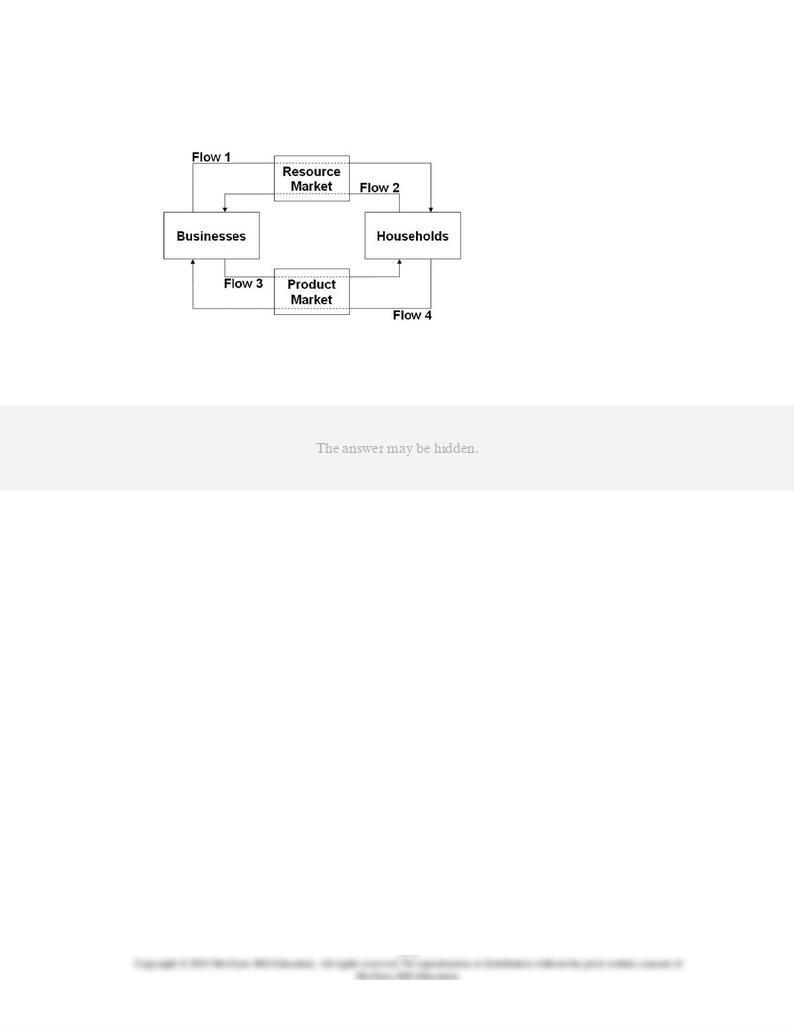
Topic: Circular flow model
Type: Figure
84.
Refer to the diagram. Flow 2 represents:
AACSB: Analytic
Blooms: Understand
Difficulty: 2 Medium
Learning Objective: 02-05 Describe the mechanics of the circular flow model.
Topic: Circular flow model
Type: Figure
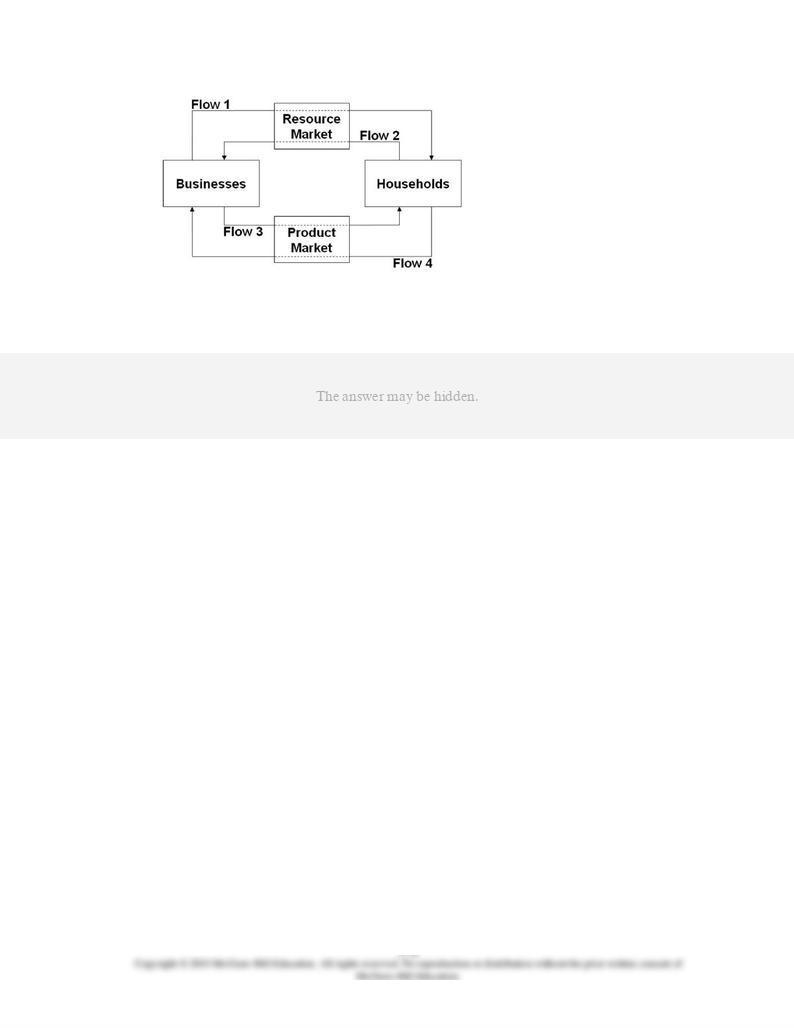
85.
Refer to the diagram. Flow 3 represents:
AACSB: Analytic
Blooms: Understand
Difficulty: 2 Medium
Learning Objective: 02-05 Describe the mechanics of the circular flow model.
Topic: Circular flow model
Type: Figure

86.
Refer to the diagram. Flow 4 represents:
AACSB: Analytic
Blooms: Understand
Difficulty: 2 Medium
Learning Objective: 02-05 Describe the mechanics of the circular flow model.
Topic: Circular flow model
Type: Figure
87.
In terms of the circular flow diagram, households make expenditures in the _____ market
and receive income through the _____ market.
AACSB: Analytic
Accessibility: Keyboard Navigation
Blooms: Remember
Difficulty: 1 Easy
Learning Objective: 02-05 Describe the mechanics of the circular flow model.
Topic: Circular flow model
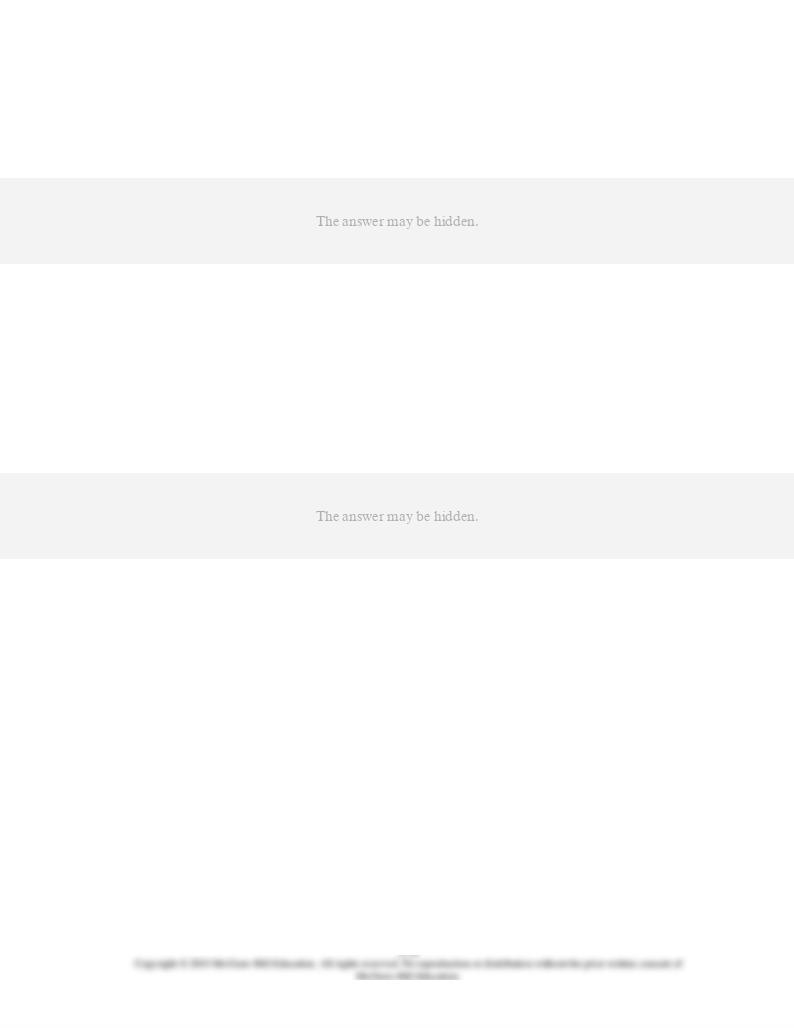
88.
In terms of the circular flow diagram, businesses obtain revenue through the _____ market
and make expenditures in the _____ market.
AACSB: Analytic
Accessibility: Keyboard Navigation
Blooms: Remember
Difficulty: 1 Easy
Learning Objective: 02-05 Describe the mechanics of the circular flow model.
Topic: Circular flow model
89.
Households and businesses are:
AACSB: Analytic
Accessibility: Keyboard Navigation
Blooms: Remember
Difficulty: 1 Easy
Learning Objective: 02-05 Describe the mechanics of the circular flow model.
Topic: Circular flow model
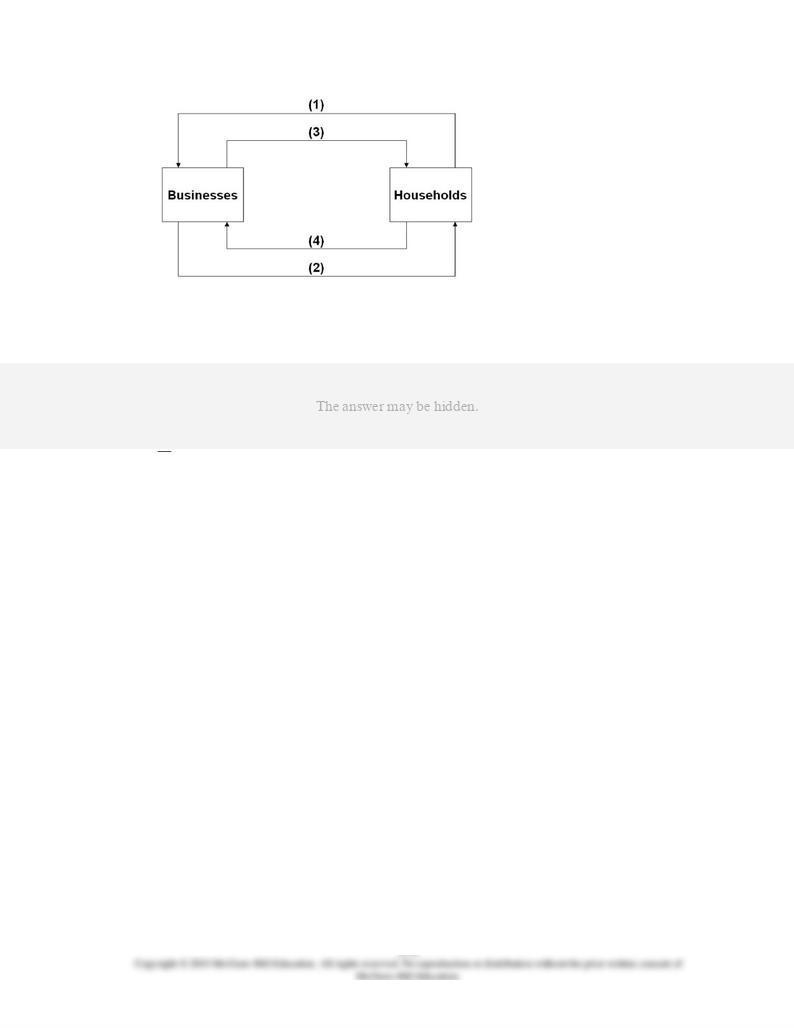
90.
Refer to the diagram. Arrows (1) and (2) represent:
AACSB: Analytic
Blooms: Remember
Difficulty: 1 Easy
Learning Objective: 02-05 Describe the mechanics of the circular flow model.
Topic: Circular flow model
Type: Figure

91.
Refer to the diagram. Arrows (3) and (4) represent:
AACSB: Analytic
Blooms: Remember
Difficulty: 1 Easy
Learning Objective: 02-05 Describe the mechanics of the circular flow model.
Topic: Circular flow model
Type: Figure

92.
Refer to the diagram. Arrows (1) and (3) are associated with:
AACSB: Analytic
Blooms: Remember
Difficulty: 1 Easy
Learning Objective: 02-05 Describe the mechanics of the circular flow model.
Topic: Circular flow model
Type: Figure
93.
Which of the following best illustrates the circular flow model in action?
AACSB: Reflective Thinking
Accessibility: Keyboard Navigation
Blooms: Apply
Difficulty: 2 Medium
Learning Objective: 02-05 Describe the mechanics of the circular flow model.

Topic: Circular flow model
94.
Risk is a problem faced:
AACSB: Analytic
Accessibility: Keyboard Navigation
Blooms: Remember
Difficulty: 1 Easy
Learning Objective: 02-06 Explain how the market system deals with risk.
Topic: Risk
95.
Which of the following statements is true about risk management in market systems
versus command systems?
AACSB: Analytic
Accessibility: Keyboard Navigation
Blooms: Understand
Difficulty: 2 Medium
Learning Objective: 02-06 Explain how the market system deals with risk.
Topic: Risk

96.
Risk management in command economies:
AACSB: Analytic
Accessibility: Keyboard Navigation
Blooms: Understand
Difficulty: 2 Medium
Learning Objective: 02-06 Explain how the market system deals with risk.
Topic: Risk
97.
In a market system:
AACSB: Analytic
Accessibility: Keyboard Navigation
Blooms: Understand
Difficulty: 2 Medium
Learning Objective: 02-06 Explain how the market system deals with risk.
Topic: Risk

98.
In a market system, employees and suppliers:
AACSB: Analytic
Accessibility: Keyboard Navigation
Blooms: Understand
Difficulty: 2 Medium
Learning Objective: 02-06 Explain how the market system deals with risk.
Topic: Risk
99.
A market system tends to restrict business risk to owners and investors. This results in
which of the following benefits?
AACSB: Analytic
Accessibility: Keyboard Navigation
Blooms: Understand
Difficulty: 2 Medium
Learning Objective: 02-06 Explain how the market system deals with risk.
Topic: Risk
100.
A market system tends to restrict business risk to owners and investors. This results in
which of the following benefits?
AACSB: Analytic

Accessibility: Keyboard Navigation
Blooms: Understand
Difficulty: 2 Medium
Learning Objective: 02-06 Explain how the market system deals with risk.
Topic: Risk
101.
(Consider This) In 1975, McDonald's introduced its Egg McMuffin breakfast sandwich,
which remains popular and profitable today. This longevity illustrates the idea of:
AACSB: Reflective Thinking
Accessibility: Keyboard Navigation
Blooms: Apply
Difficulty: 2 Medium
Learning Objective: 02-03 Explain how the market system answers the five fundamental questions of what to produce;
how to produce; who obtains the output; how to adjust to change; and how to promote progress.
Topic: Five fundamental questions
102.
(Consider This) In 2000, McDonald's introduced its McSalad Shaker, which failed to catch
on with the public and was subsequently dropped from the menu. This failure illustrates
the idea of:
AACSB: Reflective Thinking
Accessibility: Keyboard Navigation
Blooms: Apply
Difficulty: 2 Medium
Learning Objective: 02-03 Explain how the market system answers the five fundamental questions of what to produce;
how to produce; who obtains the output; how to adjust to change; and how to promote progress.
Topic: Five fundamental questions

103.
(Consider This) Since World War II:
AACSB: Analytic
Accessibility: Keyboard Navigation
Blooms: Remember
Difficulty: 1 Easy
Learning Objective: 02-01 Differentiate between laissez-faire capitalism; the command system; and the market system.
Learning Objective: 02-04 Explain the operation of the "invisible hand" and why market economies usually do a better job
than command economies at efficiently transforming economic resources into desirable output.
Topic: Demise of the command systems
104.
(Consider This) North Korea's command economy:
AACSB: Analytic
Accessibility: Keyboard Navigation
Blooms: Remember
Difficulty: 1 Easy
Learning Objective: 02-01 Differentiate between laissez-faire capitalism; the command system; and the market system.
Learning Objective: 02-04 Explain the operation of the "invisible hand" and why market economies usually do a better job
than command economies at efficiently transforming economic resources into desirable output.
Topic: Demise of the command systems

105.
(Consider This) Which of the following statements about insurance and risk is true?
AACSB: Analytic
Accessibility: Keyboard Navigation
Blooms: Understand
Difficulty: 2 Medium
Learning Objective: 02-06 Explain how the market system deals with risk.
Topic: Risk
106.
(Consider This) Martha's Milkshake Company buys earthquake insurance from the Stable
Ground Insurance Company. Based on this purchase, economists would conclude that:
AACSB: Analytic
Accessibility: Keyboard Navigation
Blooms: Apply
Difficulty: 2 Medium
Learning Objective: 02-06 Explain how the market system deals with risk.
Topic: Risk

107.
(Last Word) According to economist Donald Boudreaux, the world's tens of billions of
individual resources get arranged productively:
AACSB: Analytic
Accessibility: Keyboard Navigation
Blooms: Understand
Difficulty: 2 Medium
Learning Objective: 02-02 List the main characteristics of the market system.
Topic: Characteristics of the market system
108.
(Last Word) According to economist Donald Boudreaux:
AACSB: Analytic
Accessibility: Keyboard Navigation
Blooms: Understand
Difficulty: 2 Medium
Learning Objective: 02-02 List the main characteristics of the market system.
Topic: Characteristics of the market system
True / False Questions
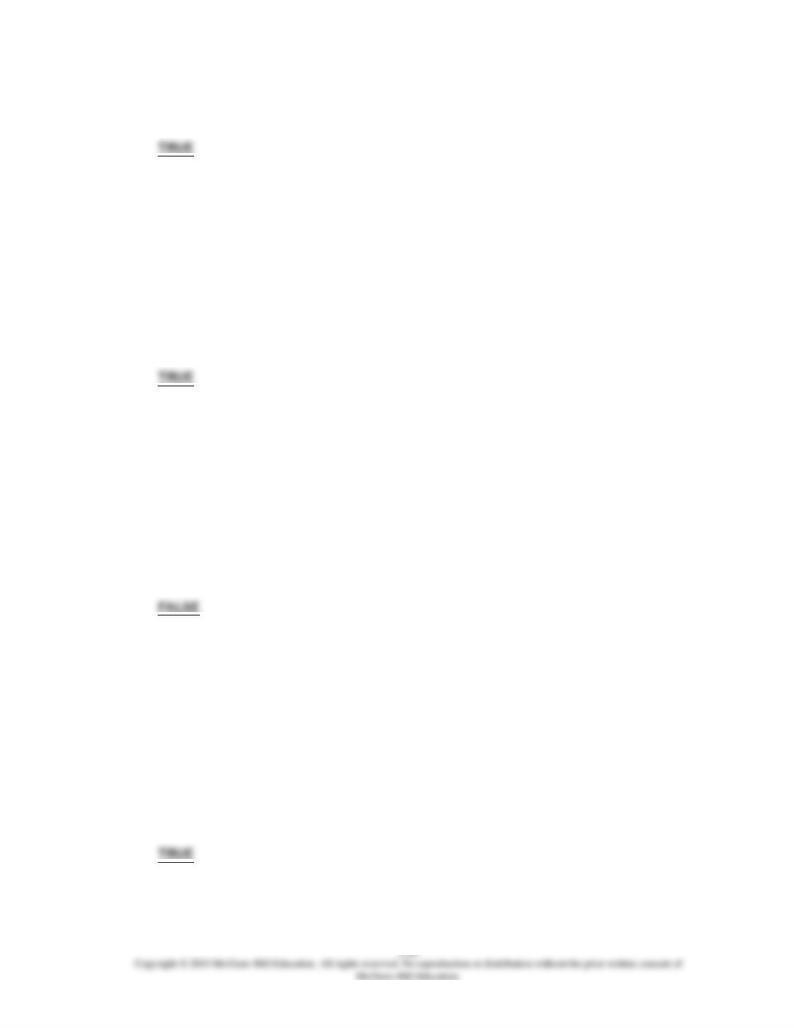
109.
Market economies use capital goods because they improve productive efficiency.
AACSB: Analytic
Accessibility: Keyboard Navigation
Blooms: Understand
Difficulty: 2 Medium
Learning Objective: 02-02 List the main characteristics of the market system.
Topic: Characteristics of the market system
110.
Money functions as a medium of exchange by eliminating the need for a coincidence of
wants.
AACSB: Analytic
Accessibility: Keyboard Navigation
Blooms: Understand
Difficulty: 2 Medium
Learning Objective: 02-02 List the main characteristics of the market system.
Topic: Characteristics of the market system
111.
Consumer sovereignty means that legislation now protects the rights of consumers to
dispose of their incomes as they see fit.
AACSB: Analytic
Accessibility: Keyboard Navigation
Blooms: Remember
Difficulty: 1 Easy
Learning Objective: 02-03 Explain how the market system answers the five fundamental questions of what to produce;
how to produce; who obtains the output; how to adjust to change; and how to promote progress.
Topic: Five fundamental questions
112.
Specialization may expand total output even though the individuals involved may have
identical abilities.
AACSB: Analytic
Accessibility: Keyboard Navigation
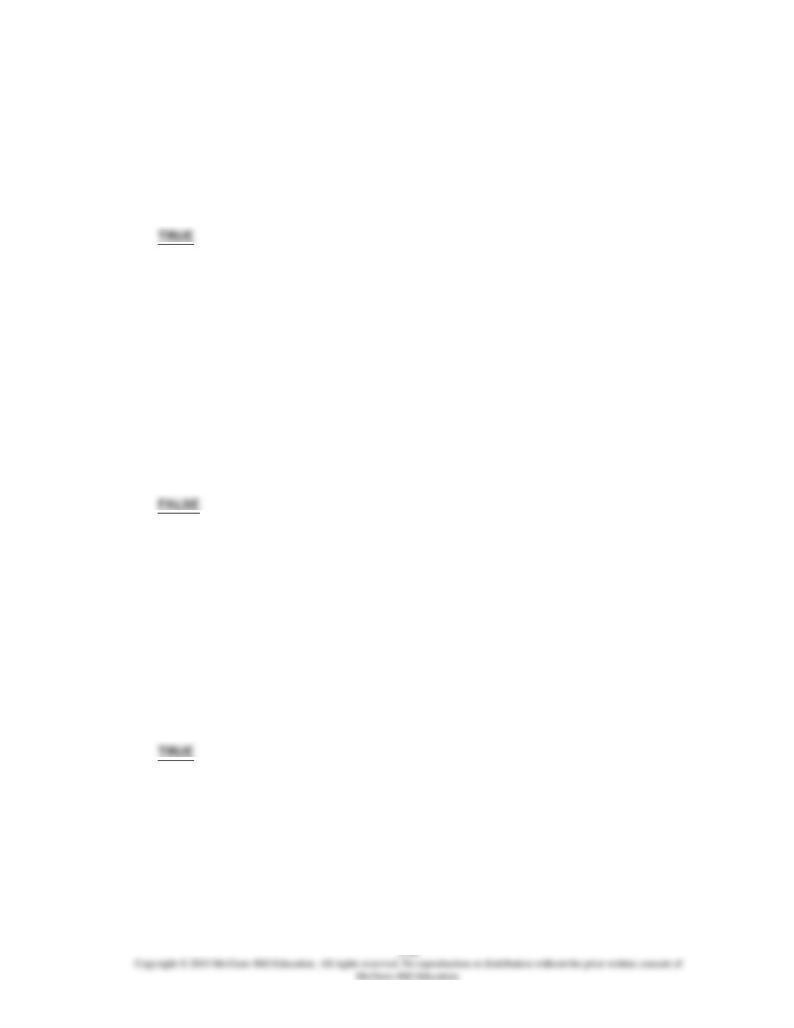
Blooms: Understand
Difficulty: 2 Medium
Learning Objective: 02-02 List the main characteristics of the market system.
Topic: Characteristics of the market system
113.
The wants of consumers are expressed in the product market with "dollar votes."
AACSB: Analytic
Accessibility: Keyboard Navigation
Blooms: Remember
Difficulty: 1 Easy
Learning Objective: 02-03 Explain how the market system answers the five fundamental questions of what to produce;
how to produce; who obtains the output; how to adjust to change; and how to promote progress.
Topic: Five fundamental questions
114.
Costs can be defined as total payments made to workers, land owners, and capital
suppliers
less
payments to the entrepreneur for organizing and combining the other
resources used to produce a good.
AACSB: Analytic
Accessibility: Keyboard Navigation
Blooms: Remember
Difficulty: 1 Easy
Learning Objective: 02-03 Explain how the market system answers the five fundamental questions of what to produce;
how to produce; who obtains the output; how to adjust to change; and how to promote progress.
Topic: Five fundamental questions
115.
Continued losses in an industry will cause some firms to reduce output or eventually leave
the industry.
AACSB: Analytic
Accessibility: Keyboard Navigation
Blooms: Understand
Difficulty: 2 Medium
Learning Objective: 02-03 Explain how the market system answers the five fundamental questions of what to produce;
how to produce; who obtains the output; how to adjust to change; and how to promote progress.
Topic: Five fundamental questions

116.
The guiding function of prices tends to keep resources flowing toward their most highly
valued uses.
AACSB: Analytic
Accessibility: Keyboard Navigation
Blooms: Understand
Difficulty: 2 Medium
Learning Objective: 02-03 Explain how the market system answers the five fundamental questions of what to produce;
how to produce; who obtains the output; how to adjust to change; and how to promote progress.
Topic: Five fundamental questions
117.
The invisible hand refers to the many indirect controls that the federal government
imposes in a market system.
AACSB: Analytic
Accessibility: Keyboard Navigation
Blooms: Understand
Difficulty: 2 Medium
Learning Objective: 02-04 Explain the operation of the "invisible hand" and why market economies usually do a better job
than command economies at efficiently transforming economic resources into desirable output.
Topic: Invisible hand
118.
Central planning in the Soviet Union and pre-reform China emphasized the expansion of
the production of consumer goods to raise the domestic standard of living.
AACSB: Reflective Thinking
Accessibility: Keyboard Navigation
Blooms: Remember
Difficulty: 1 Easy
Learning Objective: 02-01 Differentiate between laissez-faire capitalism; the command system; and the market system.
Learning Objective: 02-04 Explain the operation of the "invisible hand" and why market economies usually do a better job
than command economies at efficiently transforming economic resources into desirable output.
Topic: Demise of the command systems

119.
Central planning often suffers from a coordination problem and an incentive problem.
AACSB: Reflective Thinking
Accessibility: Keyboard Navigation
Blooms: Remember
Difficulty: 1 Easy
Learning Objective: 02-01 Differentiate between laissez-faire capitalism; the command system; and the market system.
Learning Objective: 02-04 Explain the operation of the "invisible hand" and why market economies usually do a better job
than command economies at efficiently transforming economic resources into desirable output.
Topic: Demise of the command systems